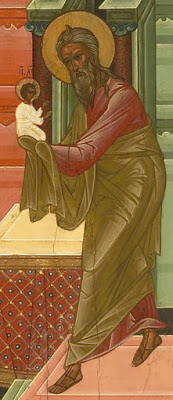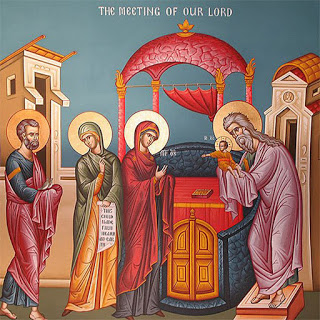
The LORD said to Moses, “Consecrate to me all the first-born; whatever is the first to open the womb among the people of Israel, both of man and of beast, is mine.” (Book of Exodus, Chapter 15)
According to the Mosaic law recorded in Exodus, the first-born son of every observant Jew should be dedicated to God in the Temple at Jerusalem forty days after his birth, where the mother would also complete her ritual purification. Forty days after the birth of Christ is celebrated, and bringing the Nativity cycle of feasts to a close, the dedication of the infant Jesus is remembered as the Feast of the Presentation (or Meeting, or Dedication) of the Lord in the Temple, known in the West as Candlemas, on Feb 2/15.

Beneath the mere outward act of submission to the Mosaic law by Ss Joseph, Mary, and Jesus lays an epochal point in the history of our salvation. This deeper meaning is revealed in the icons of this feast.
The story of Christ’s dedication in the Temple is described in Luke’s Gospel (Luke 2: 22-40). The elderly St Symeon, described in hymns as a “priest”, is inspired by the Holy Spirit to take up the Christ-child in His arms and declare: “Lord, now let Your servant depart in peace, according to Your word; for my eyes have seen Your salvation.” Symeon’s recognition of baby Jesus as the Messiah is shown in his deep reverence: bowing low and holding Christ with covered hands. Christ Himself is shown as actively blessing those present, appearing as Lord and Saviour, rather than a helpless babe-in-arms.
 The Mother of God has just given her Son into the arms of Symeon, whilst nearby is Anna, recognizable as a prophetess by the scroll she holds: sometimes closed, sometimes open. Completing the scene is Joseph, who brings a sacrificial offering to the Temple. In Leviticus, it states that forty days after the birth of the first-born son, the mother must bring a lamb and a turtledove to the priest as a burnt-offering. “And if she is not able to bring a lamb [i.e. she is too poor], then she may bring two turtledoves or two young pigeons–one as a burnt offering and the other as a sin offering.” (Lev 12:8) Joseph is shown with two turtledoves, reinforcing the humble background into which Christ was born. He carries the turtledoves on behalf of Mary, the Mother, which reminds us that despite the doubts described in the Nativity Icon, Joseph is finally reconciled to his betrothed and trusts the infant Jesus to be truly the Messiah.
The Mother of God has just given her Son into the arms of Symeon, whilst nearby is Anna, recognizable as a prophetess by the scroll she holds: sometimes closed, sometimes open. Completing the scene is Joseph, who brings a sacrificial offering to the Temple. In Leviticus, it states that forty days after the birth of the first-born son, the mother must bring a lamb and a turtledove to the priest as a burnt-offering. “And if she is not able to bring a lamb [i.e. she is too poor], then she may bring two turtledoves or two young pigeons–one as a burnt offering and the other as a sin offering.” (Lev 12:8) Joseph is shown with two turtledoves, reinforcing the humble background into which Christ was born. He carries the turtledoves on behalf of Mary, the Mother, which reminds us that despite the doubts described in the Nativity Icon, Joseph is finally reconciled to his betrothed and trusts the infant Jesus to be truly the Messiah.The Jewish Temple transformed into the Christian Church

The scene takes place in the Temple of Solomon at Jerusalem, which was not merely the main temple of Judaism, but the only temple of the Jewish faith. As is normal for classic iconography, the scene appears to occur in the open, not concealed by walls, with the outside of the Temple shown in the background. The icon of the Presentation is dominated by a four-pillared dome, which was an architectural feature of the inside of the Temple. It is a ciborium, in Greek a kivorion (κιβωριου) – a canopy contained in the sanctuary.
Before the building of the Temple, from the time of Moses, the Hebrews had the Tabernacle, which contained the Ten Commandments given to Moses, the manna from Heaven, and an altar. This portable structure was the holy place in which the presence of God was manifest. After the nation of Israel was established, King Solomon built the Temple to house the Ten Commandments and the other contents of the Tabernacle. A permanent tabernacle was created within the Temple, the sanctuary, and this is what is depicted as a ciborium.

But the ciborium in the icon is not the tabernacle of the Temple of Solomon, which was destroyed within 50 years of Christ’s dedication there. The altar in the icon is behind two gates, reminiscent of Royal Doors. Upon the altar are not the stone tablets of Moses, but a Gospel book that contains the New Testament. Sometimes the altar cloth is conspicuously decorated with the Christian cross; highly anachronistic, yet reminding us of the real significance of the event: not the observance of the old Mosaic law, but the fulfillment of it in Christ’s incarnation. The ciborium itself was a common feature of first millennium churches, covering the altar and having curtains to veil the consecrated host at particular times of the Liturgy. The icon of the Presentation is therefore clearly and consciously depicting Solomon’s Temple as a Christian church, though this is sometimes lost today when ciborium’s are not as common in church architecture.

With this “transformation” in mind, it is no coincidence that the infant Christ appears to be handed to St Symeon over the altar. Just as the stone tablets are transformed, in the icon, into a Gospel-book, so too is the heavenly manna of the Jewish tabernacle transformed into the life-giving Lamb of God, Jesus Christ: a food also of divine origin, but inexhaustible, alive, and granting eternal life (see also The Lamb of God in Orthodoxy, the section on the melismos). Here, the references to St Symeon as “priest” are entirely appropriate, regardless of his actual role at the Temple in Jerusalem, as in the icon he receives the infant Jesus as the life-giving, sacrificial offering at the Christian liturgy. St Joseph even appears like a deacon attending to Symeon, shown in the same posture of supplication as the angels in the head banner of this website, who are painted with a deacon’s vestments.

At the Theophany, we learn that Jesus did not need to receive the baptism of repentance from John in the river Jordan; Christ willingly did this to purify the waters, nature, and the ritual of baptism itself. Likewise, Christ did not need to be offered to the God Who begot Him, nor did any sacrifice for purification need to be given for He Who is spotless. Jesus entered the Temple not to be purified, but to purify others: Ss Symeon, Anna, and the whole system of Jewish worship. The passing away of animal sacrifices, the Mosaic Law, and Jewish Temple worship, were all heralded with Christ’s dedication, forty days after His birth. This feast, coming at the end of the winter Feast of Lights, usually occurs close to the beginning of Lent, when the pure sacrifice of “a contrite heart” is required of us, rather than the burnt offerings done away with with the advent of Christ.
Source: https://iconreader.wordpress.com




